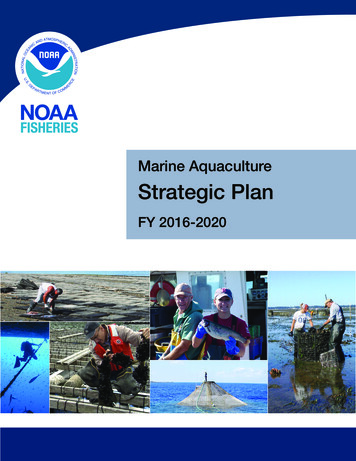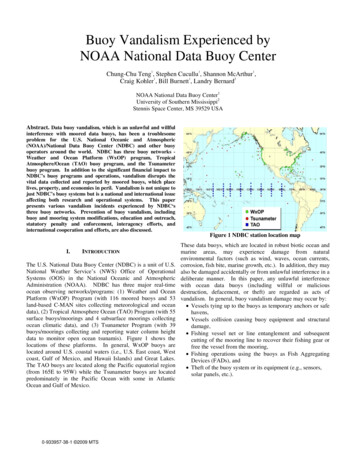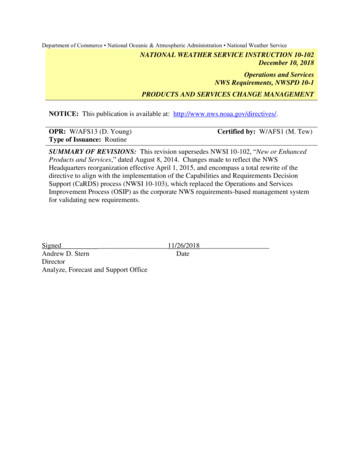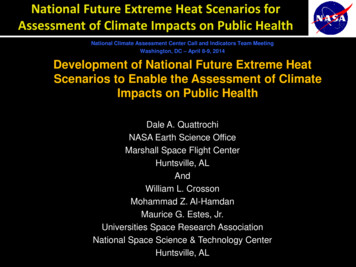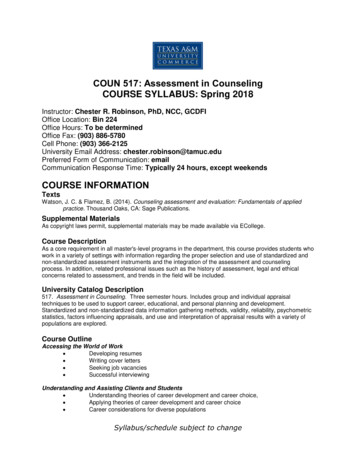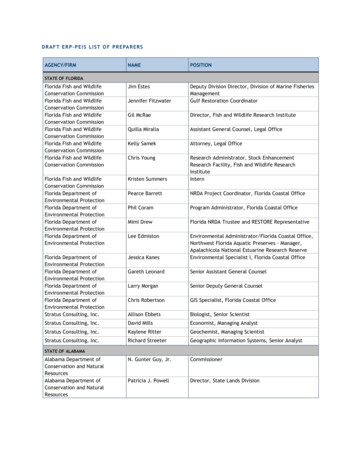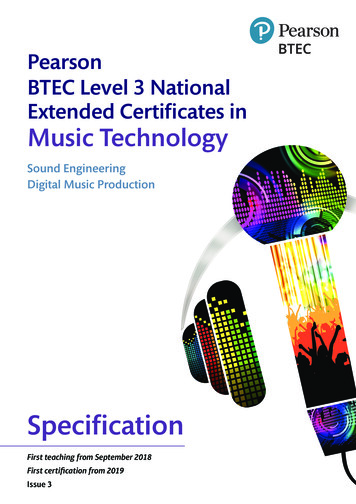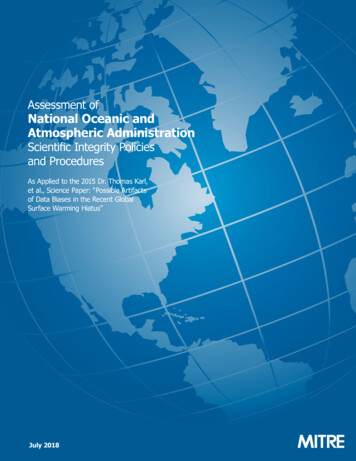
Transcription
Assessment ofNational Oceanic andAtmospheric AdministrationScientific Integrity Policiesand ProceduresAs Applied to the 2015 Dr. Thomas Karl,et al., Science Paper: “Possible Artifactsof Data Biases in the Recent GlobalSurface Warming Hiatus”July 2018MITRE
MTR180173V1MITRE TECHNICAL REPORTSponsor: Department of CommerceDept. No.: P181Contract No.: SS133017CN0002Project No.: 19178600-AAThe views, opinions and/or findingscontained in this report are those of TheMITRE Corporation and should not beconstrued as an official government position,policy, or decision, unless designated byother documentation.Approved for Public Release;Distribution Unlimited.Public Release Case Number 18-4260. 2018 The MITRE Corporation.All rights reserved.McLean, VAAssessment of National Oceanic andAtmospheric Administration ScientificIntegrity Policies and ProceduresAs Applied to the 2015 Dr. Thomas Karl, et al.Science Paper: “Possible Artifacts of DataBiases in the Recent Global Surface WarmingHiatus”July 2018Dr. Arthur B. Baggeroer (Massachusetts Institute ofTechnology)Dr. Robert B. Gagosian (Woods Hole OceanographicInstitution)Dr. Domenico Grasso (University of Michigan)Dr. Michael B. McElroy (Harvard University) [Co-chair]Dr. Jay J. Schnitzer (MITRE) [Co-chair]Dr. Cindy Lee Van Dover (Duke University)Dr. Steven C. Wofsy (Harvard University)Dr. Linda Zall (Central Intelligence Agency, Retired)Susan Boa (MITRE)Anne Cady (MITRE)Dr. Robert Edson (MITRE)Kevin Gunn (MITRE)Dr. James Providakes (MITRE)Kevin Toner (MITRE)
This page intentionally left blank.2
Executive SummaryOn June 26, 2015, scientists from the National Oceanic and Atmospheric Administration(NOAA) published a manuscript in Science Magazine, “Possible Artifacts of Data Biases in theRecent Global Surface Warming Hiatus,” addressing the perceived decrease in the upward trendof global surface temperatures. Based on a revised interpretation of the observational data for theocean, Karl, et al. (2015) (hereafter referred to as “the Karl Study”) concluded that “the rate ofwarming during the first 15 years of the 21st century is at least as great as the last half of the 20thcentury.” The paper was critiqued in a February 2017 blog posting written by former NOAAemployee, Dr. John Bates.The Department of Commerce (DOC) engaged MITRE as an independent not-for-profit entity toobjectively assess the processes used to develop and publish the Karl Study. MITRE, whichoperates federally funded research and development centers, has a 60-year history of leveragingindependent expertise in science and systems engineering to inform government decisionmaking. MITRE assembled a team of leading scientists from prestigious institutions tocollaborate with MITRE personnel to provide an objective analysis of all available informationrelevant to this assessment. The teaming between MITRE and the assembled scientists will bereferred to as “the MITRE Committee.”This report addresses the following tasks in the MITRE Statement of Work from the DOC: Task A: Assess NOAA’s scientific review process for assurance of unbiased decisionmaking when completing and publishing the Karl Study Task B: Assess the merits to Dr. John Bates’ complaints regarding the data andconclusions made in the Karl StudyTo perform Task B, the MITRE Committee examined the questions, criticisms, and concernsregarding the Karl Study that were raised by Bates in a blog post dated February 4, 2017.The MITRE Committee was also tasked with examining the adequacy of the following protocolsand whether they were followed adequately in the Karl Study: Procedures in place at NOAA to ensure the scientific integrity of work by its staff Mechanisms for internal review of manuscripts projected for external release Procedures for the classification of papers judged as “policy relevant” requiring eitherappropriate disclaimers or stringent NOAA internal peer reviews Methods for selecting and applying the data used in the Karl Study Procedures to distinguish between the treatment and use of data developed for immediatescientific release and data destined for inclusion in more-permanent archivesSections 2 and 3 of this report are devoted to the MITRE Committee’s analysis and findingsregarding Tasks A and B and the additional assessment topics above tasked by the DOC.Section 4 summarizes the MITRE Committee’s findings. The MITRE Committee was tasked toprovide recommendations, as appropriate, for changes in existing NOAA policies and proceduresto address its findings. Section 5 provides the MITRE Committee’s recommendations.Finally, this report includes an Afterword, which is a projection of the prospects for futureadvances in observational systems and analytical procedures. It is the MITRE Committee’sbelief that these future advances may be expected to markedly enhance the climate sciencecommunity’s ability to diagnose and contextualize the relative importance of the multipleiii
factors, both natural and human related, that combine to determine the function and properties ofdata used to assess the climate system.The findings and recommendations are summarized below. The MITRE Committee determinedthat no recommendations were necessary for Findings 1, 2, and 7-10.Finding 1: After carefully reviewing internal NOAA email correspondence, the MITRECommittee found no evidence that the Karl Study falsified, or intentionally distorted climatedata. The Karl Study data were subsequently used in multiple peer-reviewed scientificpublications.Finding 2: Under the Office of Management and Budget (OMB) Guidelines and the 2013NOAA and Department of Commerce procedure documents for internal review and approval offundamental research communications (FRCs), research submitted for outside peer review maybe exempt from the agency review requirements of the Information Quality Act (IQA) if certainrequirements are met. Because the authors published the Karl Study in Science Magazine, andnot through NOAA, the OMB exemption was applied. However, the MITRE Committeedetermined that the 2013 NOAA guidelines were ambiguous and not clear on when the morestringent agency IQA review requirements should apply. In 2016, NOAA updated theFramework for Internal Review and Approval to reference the OMB exemption. While this newlanguage is an improvement over the 2013 NOAA guidance, it should be written more clearlyand presented more prominently in the guidance.Finding 3: Because the NOAA officials knew in advance of publication that the paper would beinfluential, impactful, and controversial, the authors of the Karl Study should have included adisclaimer in the paper to indicate that the views expressed in the paper represented the opinionsof the authors and, as indicated with the guideline suggested in the NOAA Framework forInternal Review and Approval, that it “did not necessarily reflect the views of NOAA or theDepartment of Commerce.”Recommendation: Develop a new NOAA policy document for the production offundamental research communications (FRCs).Finding 4: NOAA policies and procedures for climate data management do not provide cleardirection and requirements for distinguishing research and operational data and for determiningwhen and how to archive climate data and make it publicly available.Recommendation: Update current NOAA policies, and develop and implement newprocedures for environmental data management.Finding 5: The NOAA internal review, which was conducted by one NOAA scientist during afive-day period, was not considered by the MITRE Committee to be a sufficient internal review,given the anticipated importance and controversy of the paper.Recommendation: Develop and widely disseminate a new NOAA Peer ReviewHandbook for FRCs.Finding 6: The Karl Study was submitted to Science one day before written confirmation of thecompletion of the internal NOAA review process, which was not compliant with NOAA publicrelease procedures.Recommendation: Develop and widely disseminate a new NOAA Peer ReviewHandbook for FRCs.iv
Finding 7: At the time of publication, the Karl Study data were available to the public and werein full compliance with Science and community standards.Finding 8: The Science peer review was thorough, not expedited, and exceeded the averageScience review time.Finding 9: After review of the evidence, the MITRE Committee found the Administration didnot apply pressure on the Karl Study team, or on NOAA, to influence national and internationaldeliberations on climate policy.Finding 10: Use of 90-percent confidence intervals was warranted and appropriate because thatwas the standard used by the Intergovernmental Panel Climate Change (IPCC) Fifth AssessmentReport (AR5).v
AcknowledgmentsMITRE would like to thank Dr. Thomas R. Karl and Dr. John J. Bates, both retired from NOAA,for their cooperation in this assessment.We would also like to thank the MITRE Committee, who authored this assessment with MITREand contributed much thoughtful review and commentary:MITRE Committee: Dr. Arthur B. Baggeroer (Massachusetts Institute of Technology) Dr. Cindy Lee Van Dover (Duke University) Dr. Robert B. Gagosian (Woods Hole Oceanographic Institution) Dr. Domenico Grasso (University of Michigan) Dr. Michael B. McElroy (Harvard University) [Co-chair] Dr. Jay J. Schnitzer (MITRE) [Co-chair] Dr. Steven C. Wofsy (Harvard University) Dr. Linda Zall (Central Intelligence Agency, Retired)vi
Table of ContentsIntroduction . 111.1Background . 111.2Purpose. 121.3Scope . 121.4Methodology . 131.4.1Assemble MITRE Committee. 131.4.2Data and Interview Requests . 141.4.3Formulate Assessment Questions . 151.4.4Data Discovery and Cataloging . 151.4.5Related Internal NOAA Correspondence (Emails) . 151.4.6Initial Data Analysis . 161.4.7Develop Findings and Recommendations . 161.4.8Compile Final Report . 161.5Report Organization . 17Task A: Assessment of NOAA Scientific Review Process and Application to the Karl StudyPublication . 192.1NOAA Scientific Integrity Policies and Procedures . 192.1.1Scientific Integrity . 192.1.2Publications and Peer Review. 202.1.3Climate Data and Records Management. 222.1.4Addressing Scientific Integrity Concerns . 232.2The Karl Study’s Analysis of Sea and Land Surface Temperature Data . 23Task B: Assessment of Dr. John Bates’ Critiques of the Karl Study Publication . 293.1Criticism Concerning the Procedures Followed in the Internal Review of the Karl Study(Bates Blog Posting and Email) . 293.2Concern That There Was a “Rush to Time the Publication of the Paper to InfluenceNational and International Deliberations on Climate Policy” . 313.3Science Publication Selection . 343.4The Use of Research Data Rather Than Operational Data . 343.4.1NOAA Environmental Data Management . 353.4.2NOAA Scientific Records Appraisal and Archive Approval . 353.4.3NOAA CDR Program . 363.4.4NOAA Policy on Research and Development Transition to Operations . 363.4.5Transitioning NOAA CDRs from Research to Operations. 363.4.6Transitioning NOAA CDRs from IOC to FOC . 36vii
3.5Concern About Adjusting the Buoy Temperature Data Rather Than the Ship Data . 373.6Failure to Disclose Critical Information to Science Regarding Data Set Archival andDocumentation . 373.7Timing of the Release of ERSST v4 . 383.8Use of 90-Percent Confidence Threshold for Evaluating the Statistical Significance ofSurface Temperature Trends . 39Significant Findings . 40Recommendations . 425.1New NOAA Policy for Fundamental Research Communications . 425.2New NOAA Peer Review Handbook for Fundamental Research Communications . 435.3Updated Policies and New Procedures for Environmental Data Management . 445.3.1Update Current Policy for NOAA Environmental Data Management . 445.3.2Update Current Policy for NOAA Research and Development Transitions . 445.3.3New Procedural Document for NOAA Environmental Data Management. 45An Afterword . 46References . 49viii
AppendicesAppendix ADepartment of Commerce Statement of Work . 57Appendix BBackground on Data Sets and Select Organizations . 59Appendix CNOAA MITRE Committee Members . 62Appendix DAbbreviations and Acronyms . 65List of FiguresFigure 1. Assessment Method . 13Figure 2. Report Organization . 18Figure 3. Global Average Temperature Anomaly Charts: (A) Met Office, NOAA, and NASA,(B) Berkeley Earth, and (C) JMA . 28Figure 4. Relationship of FRCs, ISI, and HISAs . 44List of TablesTable 1. Karl Study Comparisons of Old and New Temperature Analyses (in C per decade) . 25Table 2. Relevant Data Sets . 59Table 3. Significant Organizations and Reports . 61ix
This page intentionally left blank.x
IntroductionOn June 26, 2015, scientists from the National Oceanic and Atmospheric Administration(NOAA) published a manuscript in Science, “Possible Artifacts of Data Biases in the RecentGlobal Surface Warming Hiatus” [1] (hereafter referred to as “the Karl Study”), addressing thepreviously reported decrease in the upward trend of global surface temperatures in the FifthAssessment Report (AR5) of the Intergovernmental Panel on Climate Change (IPCC) [2]. TheKarl Study was met with many questions from the scientific community, in the form ofnumerous letters [3] [4], publications [5] [6], blogs [7] [8], and congressional inquiries [9] [10],regarding the quality of the scientific research processes used to conduct and publish the KarlStudy. One critic of the Karl Study was Dr. John Bates, a NOAA scientist and former colleagueof Karl who, in a February 4, 2017 blog posting, documented several concerns, criticisms, andissues [7].To explore these assertions and ensure that NOAA scientific processes remain beyond reproach,the Department of Commerce (DOC) proactively engaged an independent entity to objectivelyassess the processes used to develop and publish the Karl Study. The DOC engaged MITRE,which operates seven federally funded research and development centers (FFRDCs) chartered inthe public interest. An FFRDC is a unique organization that serves as a long-term strategicpartner to the government by channeling independent expertise to advance government missions.FFRDCs provide objective guidance in an environment free of conflicts of interest, and assistwith a range of critical needs, including independent study and analysis.This report addresses the following tasks that the DOC contracted with The MITRE Corporation1(for details, see Appendix A): Task A: Assess whether NOAA followed a proper scientific review process for assuranceof unbiased decision making when completing and publishing the Karl Study [1] Task B: Determine whether there were merits to Dr. John Bates’ complaints regarding thedata and conclusions made in the Karl Study [7]The DOC also gave MITRE nine specific directions related to assessing NOAA’s scientificintegrity policies and procedures as applied to the Karl Study, and directed MITRE to providerecommendations as needed.To create expert responses to these tasks, MITRE assembled a committee of leading scientistsfrom prestigious institutions to team with MITRE to provide an objective analysis of all availableinformation relevant to this assessment (see Section 1.4.1 and Appendix C for details). Hereafter,the work of MITRE and the MITRE Committee will be referred to jointly as the MITRECommittee.To provide the context for the Karl Study, and the questions that followed, this section beginswith a concise account of the role played in climate assessments by analyses of trends in globalaverage surface temperatures.1.1 BackgroundThe concept of the trend in global average surface temperatures is a tool for detecting andtracking changes in the Earth’s energy budget—how much sunlight Earth absorbs minus howmuch it radiates to space as heat—over time. Scientists use four major data sets to study global1www.mitre.org.11
temperature. The United Kingdom (UK) Met Office Hadley Centre and the University of EastAnglia’s Climatic Research Unit jointly produce the Hadley Center/Climate Research Unit(HadCRUT4).2 In the United States (U.S.), the Goddard Institute for Space Studies SurfaceTemperature Analysis (GISTEMP) series comes via the National Aeronautics and SpaceAdministration (NASA) Goddard Institute for Space Sciences (GISS),3 and NOAA creates theMerged Land-Ocean Surface Temperature Analysis (MLOST) record.4 The JapanMeteorological Agency (JMA) produces a fourth data set.5AR5 of the IPCC [2] made note of an apparent slowdown in the trend of global average surfacetemperatures over the period of 1998 to 2012—the so-called “hiatus.”The climate models for IPCC AR5 were provided through the Coupled Model IntercomparisonProject Phase 5 (CMIP5),6 an international initiative coordinated through the World ClimateResearch Program (WCRP).7 The IPCC report noted that 111 of the 114 simulations conductedunder CMIP5 projected global-mean-surface-temperature trends over the period of 1998 to 2012that were significantly warmer (a mean of 0.21 C per decade) than the observational results fromHadCRUT4 (0.05 C per decade), despite generally satisfactory agreement between models andinferred observational trends during earlier periods.The records of trends in global average surface temperatures reported in HadCRUT4 are inexcellent agreement, as noted by IPCC AR5, with independent results reported by the two othergroups conducting such studies at that time, NASA GISS (GISTEMP) and NOAA (MLOST)(see Section 2). The suggestion that the impact on climate of increasing emissions of greenhousegases may have been overestimated in the climate models set the scene, and was a motivationfor, the Karl Study, as was a question of residual data biases in global-surface-temperature data.1.2 PurposeThe purpose of this report is to present assessment results compiled by the MITRE Committee toaddress the two tasks, nine directions, and the request for recommendations for the futurecontained in the DOC Statement of Work (SOW) (see Section 1.1 and Appendix A).1.3 ScopeThis report addresses the two tasks in the DOC SOW (see Appendix A), the nine directions, andthe request for recommendations. The MITRE Committee made no attempt to analyze or validatethe results of the Karl Study [2] or those of AR5 of the IPCC [11]. Also, this report is not anadditional scientific peer review of the Karl Study. Finally, it does not address the underlyingcauses of global surface temperature change, whether natural or from humans. These matters lieoutside the charge to the MITRE erature/.https://data.giss.nasa.gov/gistemp/.4 data/mlost.5 p/ann wld.html.6 https://cmip.llnl.gov/cmip5/.7 https://www.wcrp-climate.org/.312
1.4 MethodologyThis section summarizes the phases and activities of this assessment. Figure 1 depicts a highlevel overview of the assessment activities from October 2017 through March sPerform Data Discovery and CatalogingAssemble Assessment CommitteePerform Initial Data AnalysisData and Interview RequestsCompile Final ReportFigure 1. Assessment Method1.4.1 Assemble MITRE CommitteeIn parallel with the data discovery and analysis in Sections 1.4.4 and 1.4.6, MITRE assembledleading scientists from prestigious institutions to team with MITRE to provide an objectiveanalysis of all available information relevant to this assessment, applying the following criteria inthe selection process: Qualifications:o From a prestigious institution/organizationo Prominent/world-class in their fieldo Published in peer-reviewed journals in their field and cited widelyo Climate/atmospheric/oceanographic/environment scholars included, but notexclusivelyo Expertise in scientific integrity policies and procedures, acquisition, production, andpreservation of data Potential biases to be balanced across the MITRE Committee:o Climate-related publicationso Social-media activity relatively clean of strong opinions on climate changeo Recently worked for or contracted with NOAA (since 2014) Disqualifiers:o Currently work for or contracted with NOAAo Were involved in the contested study in any wayo Have published rebuttals of any of the study authors’ work13
o Have been found in violation of scientific integrity standardsMITRE performed checks of publicly available information (e.g., publications, biographies,citations, social-media activity) for initial background, and followed up, in most cases, with aconversation. MITRE considered 50 individuals. Nine of the individuals declined, while17 individuals consented to serve if asked. For due diligence, the DOC performed a formal legalbackground check on the leading candidates (there were no issues). MITRE selected the final setof eight experts based on its criteria above (listed alphabetically by last name): Dr. Arthur B. Baggeroer (Massachusetts Institute of Technology) Dr. Cindy Lee Van Dover (Duke University) Dr. Robert B. Gagosian (Woods Hole Oceanographic Institution) Dr. Domenico Grasso (University of Michigan) Dr. Michael B. McElroy (Harvard University) [Co-chair] Dr. Jay J. Schnitzer (MITRE) [Co-chair] Dr. Steven C. Wofsy (Harvard University) Dr. Linda Zall (Central Intelligence Agency, Retired)The selected Committee members bring expertise not only in climate-related scientific areas, butin other areas as well, such as engineering and mathematical sciences, medical research, physics,electrical engineering, and strategic technology assessments.Sub-contracted to MITRE, the MITRE Committee members were formally notified of theirselection on November 30, 2017. MITRE gave the MITRE Committee access to all of theinformation gathered to date. The first formal meeting of the MITRE Committee occurred onDecember 18, 2017.1.4.2 Data and Interview RequestsDuring MITRE’s data gathering and analysis, questions arose that required either additional,non-publicly available information, or clarification by speaking to an individual within NOAAwith the specific knowledge required. MITRE sent all such requests through the DOC toexpedite responses. Once contact was made with the right experts within NOAA, email andphone conversations increased the efficiency of data gathering.In addition to “principals” in this review (Dr. Karl and Dr. Bates), the MITRE Committeereceived information from, or otherwise corresponded with, the following individuals at NOAA: Mike Tanner, Director of the Center for Weather & Climate Julie Kay Roberts, Director of Communications Cynthia Decker, Executive Director of the NOAA Science Advisory Board and NOAAScientific Integrity Officer David Bedell, Office of the Chief Information Officer Tom Gleason, NOAA Office of the General Counsel Patricia Geets Hathaway, NOAA Scientific Integrity Office14
1.4.3 Formulate Assessment QuestionsTo guide and organize its initial research efforts, MITRE developed a set of basic “assessmentquestions” to collect information to support the MITRE Committee’s work to be responsive tothe SOW directions. Four topic areas are addressed in the SOW: (a) NOAA scientific integritypolicy and procedures, (b) NOAA climate data management practices, (c) NOAA publicationpolicy and procedures, and (d) NOAA protocols addressing scientific concerns. For each of thefour topic areas, the MITRE Committee addressed three questions:1. What were NOAA-applicable policies/procedures at the time of the Karl Study?2. Were these policies/procedures consistent with best practices, in the opinion of theMITRE Committee?3. Were these policies/procedures applied to the Karl Study?1.4.4 Data Discovery and CatalogingAfter scoping the assessment questions, MITRE gathered the necessary, supporting, publiclyavailable information; identified the information to be requested from DOC or NOAA; andplanned interview candidates for follow-on questions. Data were gathered in the following areas: NOAA policies, procedures, and guidelines (publicly available) Science publication policies Relevant “best practices,” if available—including those from other federal agencies,industry, and the National Academy of Sciences8 Related published information, including the Karl Study [2] and supplemental material[11], all of the paper’s cited works, and other related publications The collection of media (press, blogs, etc.) discussing the controversy around this studyand the subsequent Bates blog post Climate data used in the Karl Study9 Additional artifacts and correspondence related to the ongoing House Committee onScience, Space, and Technology review1.4.5 Related Internal NOAA Correspondence (Emails)Across the study, email correspondence provided a resource for understanding the application ofthe NOAA processes and procedures, and for determining the specific activities related to theKarl Study. The NOAA email corpus used for this project was obtained via a request through theDOC Office of General Counsel (OGC). The resultant email corpus was approximately 135gigabytes (GB) in size and included approximately 606,000 emails and related attachments.Specific searches within the email corpus were conducted in several ways. In all cases, thesearch queries were tightly related to the assessment topics and questions. While it is possiblethat not all appropriate emails were identified, as discovery was ultimately limited by the fidelityof the searches, the MITRE Committee is confident the search was thorough and providedsufficient information for an objective assessment. Care was taken by all researchers to limit pub/data/scpub201506.15
review to study-related queries. The privacy of NOAA and other federal staff was respected at alltimes during the review.1.4.6 Initial Data AnalysisMITRE analyzed the gathered data to organize the varied sources for the MITRE Committee’sanalysis and to identify and investigate additional, potentially relevant sources. Morespecifically, MITRE performed the following actions:
v Finding 7: At the time of publication, the Karl Study data were available to the public and were in full compliance with Science and community standards. Finding 8: The Science peer review was thorough, not expedited, and exceeded the average Science review time. Finding 9: After review of the evidence, the MITRE Committee found the Administration did
